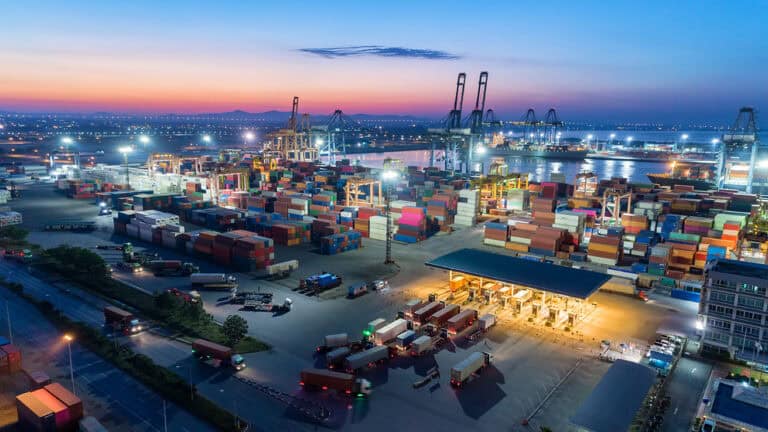
Summer is right around the corner, and that means weekends and holidays filled with social activities. A trio of federal holidays in the U.S. (Memorial Day, Independence Day, and Labor Day) allows us to host or attend parties with our friends and family. Parents pile the kids into the car to take road trips, invite people over for cookouts in the warm weather, or head to a nearby beach or campground with coolers in hand. Maybe more so than any other season, it seems like summer is the time for food and beverages to be the stars of the show.
Of course, most people probably don’t stop to think about where their potato salad came from or how it got there. The supply chain operations required to get those products from production to plate are massive and fraught with peril. Between the rising volume of online grocery orders, the need to ensure cold chain integrity to move perishables, demands for sustainability and food safety, and the changing regulations of the Food & Drug Administration, this industry has a lot to chew on.
The key to managing all these moving parts is ensuring logistics visibility into supply chain partners and products on the move, but to do that you need the right tools to give you the necessary level of insight. In this blog, we will discuss how food and beverage companies can increase the transparency of their logistics operations to ensure safety and quality, and the satisfaction of the “grill masters” at the end of the supply chain.
Choosing the right transportation management system
Every cookout has that guest who is constantly eyeballing the grill to see when the next round of burgers will be ready. In much the same way, shippers are always on the lookout for ways to simplify and streamline transportation operations. That’s because a whole slew of factors — including supply chain complexity, unstable markets, fluctuating demand, and sustainability requirements — have all put enormous pressure on food and beverage supply chains.
A common solution to all this uncertainty is a transportation management system (TMS), a technology platform that allows you to manage your logistics activities from a centralized hub. While a TMS can certainly help some companies manage their logistics, it should be noted that they’re not all created equal. There are several ingredients that should be on your shopping list when you’re considering choosing one. After all, you wouldn’t visit three different grocery stores to buy all the buns, sides, utensils, and drinks you need for your cookout, so why settle for a TMS that doesn’t provide everything you need in one place?
A leading TMS upgrades your planning and execution capabilities — and provides access to transportation and supply chain partner data — to give you the transportation visibility to keep things running on time. The end-to-end visibility helps you to avoid delays because you can see them forming upstream and make the necessary updates to ensure you hit the expected delivery dates and times. In other words, you can make sure that there are plenty of hot dogs available in stores for all the cookouts.
E2open has developed a proprietary TMS that provides real-time transportation visibility and enables centralized management of all modes of transport. Automation of planning functions for both negotiated and on-demand rates help you keep costs down, and real-time notifications help you proactively respond to disruptions or issues before or during rather than after the fact. Access to real-time data and collaborative functions improves overall supply chain management and enables multiple partners to access information and make decisions through a common platform. This level of transportation planning has an added benefit: it lets you make choices that are environmentally friendly but also optimizes cost and timing and reduces freight spend.
Meeting the demands of on-time, in-full delivery
It’s not just the guests at your barbecue waiting for their food. On-time, in-full (OTIF) delivery is one of the most important performance metrics for a food and beverage company. It measures a company’s ability to fulfill orders in a complete, timely manner. In addition to helping ensure better customer satisfaction, it also plays a crucial role in optimizing costs by avoiding overstocking or stockouts.
Transportation visibility plays a key role in OTIF by allowing shippers to identify potential issues on the horizon. Unfortunately, modern supply chains are fragmented and peppered with blind spots that make it difficult to know the status of a shipment. In many cases, shippers only find out about an issue after the fact, when they receive a complaint about a late delivery from an unhappy customer. To gain more visibility into upstream and downstream supply chain partners, many companies have begun leveraging technology, such as real-time tracking solutions and collaborative software platforms. The e2open Logistics Visibility solution provides real-time status of goods on the move for all shipment modes, legs, and regions, allowing for greater certainty to make informed decisions. And it’s all available on a single, collaborative, cloud-based platform.
By connecting all supply networks on one platform, supply chain management teams can leverage data to identify where carriers may be experiencing issues and choose the best course of action to avoid OTIF penalties. They can also capture and share data about Works in Progress (WIPs) to ensure OTIF is met with reduced risk and lower cost. This level of insight allows food and beverage companies to optimize operations, measure delivery performance, raise customer service levels, and remove functional siloes.
Logistics visibility challenges and reliable carrier options
Like a wasp at a backyard cookout, disruption has a way of showing up in your supply chain uninvited. When it comes to logistics, that disruption can stop your entire operation in its tracks. Combined with increased visibility, having access to a partner network with reliable carrier options can seriously boost your ability to respond to whatever the market throws at you. The problem is that building those networking connections can take years, even decades.
E2open has carefully curated a community of carrier partners that allows our food and beverage customers to find reliable carrier options 24 hours a day, seven days a week. This vast partner network provides access to 50,000 proven logistics partners. It includes ocean, air, rail, truck, and parcel carriers, freight forwarders, and logistics service providers, covering every available mode of transport. Uniting these partners on our shared platform empowers collaboration and flexibility and gives shippers greater access to carrier capacity, helping companies hit delivery targets while optimizing freight spend. The network also provides access to reliable data, enabling real-time decision-making and supporting business transformation across the entire supply chain.
Of course, not every company has the resources, capabilities, or capacity to manage its own logistics operations. Some opt to outsource this competency to a third party, a practice known as Logistics as a Service (LaaS). With the right LaaS provider, companies can continue to maintain visibility and control over their logistics activities while managing relationships and pricing agreements with key partners. Outsourcing logistics can also help lower costs, save time, increase profits, and even improve customer satisfaction.
Satisfy your stake holders
Food and beverage companies today face many complex challenges. They must keep up with unpredictable supply and demand and consumers’ constantly changing habits. They are facing more stringent ESG standards and increased scrutiny from the public, investors, and regulators. They must deal with fluctuations in the pricing of raw materials and manage shifting cross-border compliance regulations. As if that weren’t enough, the competitive playing field is also growing.
There’s a real need for a connected, end-to-end solution that combines oversight of these disparate food and beverage challenges on one platform. It’s become obvious that the old legacy technology solutions – or worse, manual processes – are not going to see food and beverage companies through all this volatility. By investing in and implementing newer technologies, such as transportation management systems or automation and AI, companies are doing more than just keeping up with the current evolution of supply chains — they’re also positioning themselves to keep up with the next wave of evolution. With the right tools, food and beverage companies can keep the party going and ensure that this summer, the grill stays hot and the drinks keep flowing.
If you’d like to learn more about maximizing delivery performance with a connected TMS, contact us today or visit e2open.com.







